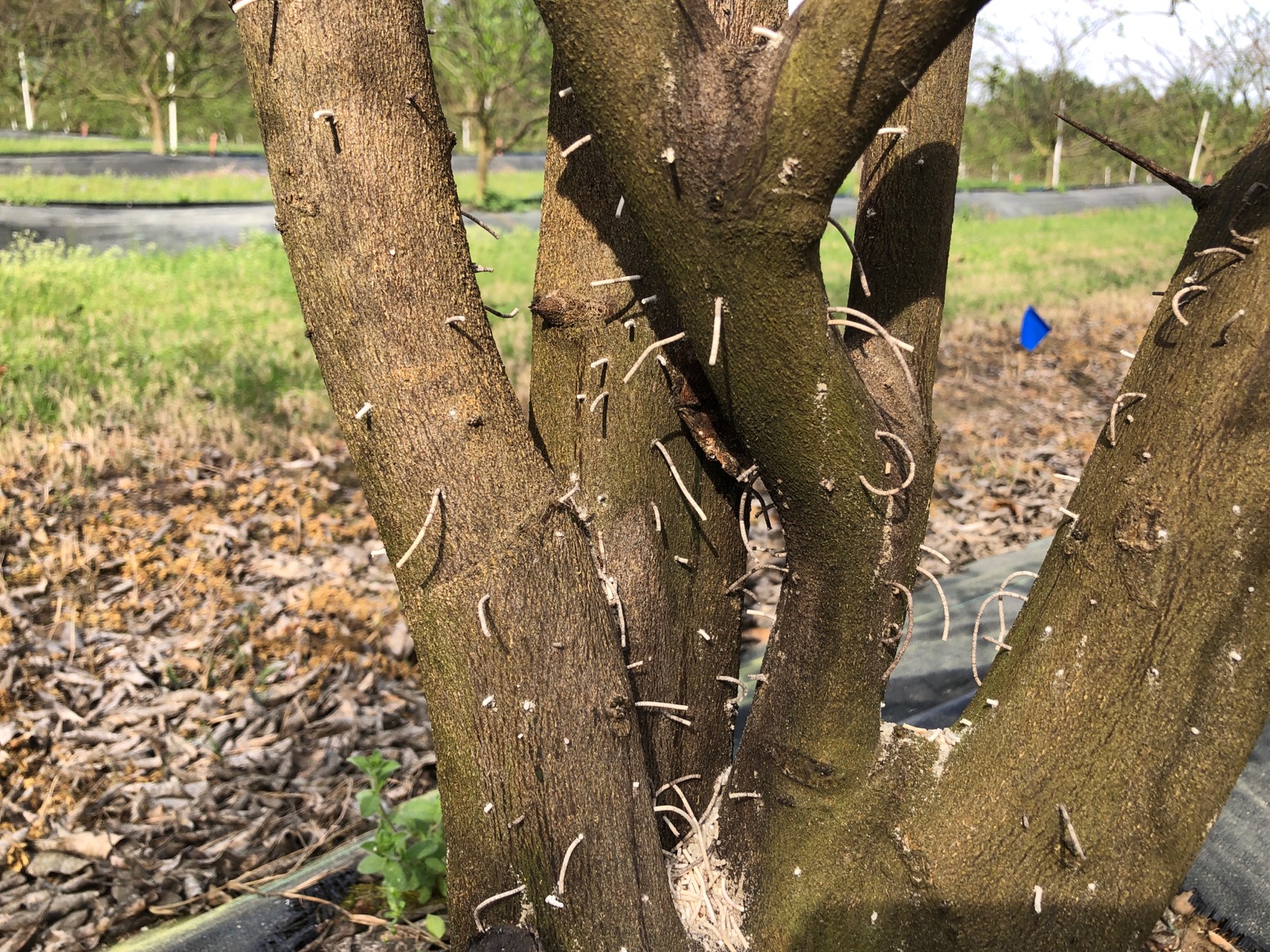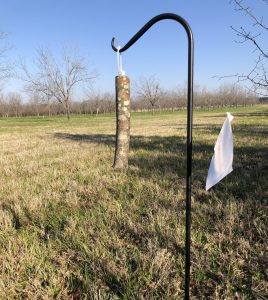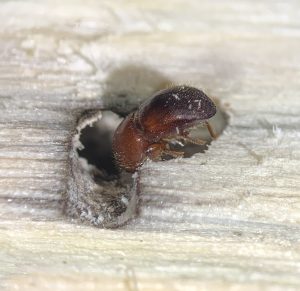Keeping Up with Ambrosia Beetles

A good example of the sawdust toothpicks extruded by ambrosia beetles. In this case, a citrus tree is being attacked. (Photo by Jake Price; University of Georgia)
The ambrosia beetles, as a group and as individual species, are known to attack a broad range of woody plants. Although they bore into trees and create galleries where they reproduce, these beetles do not feed on the host tree. Ambrosia beetles exist symbiotically with a fungus they carry in a specialized structure, i.e., a mycangium, on their body. There are many species of this fungus, and some ambrosia beetle species may be associated with more than one species of this fungus. Once the female beetle has bored into the host tree, the fungus is released and grows within the excavated gallery. This fungus, ambrosia, is the food of the ambrosia beetle and its offspring. Ambrosia beetles do not reproduce in galleries that do not contain this fungus. Although this symbiotic fungus is not a tree pathogen, sometimes the beetles can transport secondary microorganisms that are tree pathogens into the gallery. Even though the ambrosia fungus may not be pathogenic, a young pecan tree can be overwhelmed by numerous ambrosia beetles boring into it.
Reports state that certain tree species may be attacked more frequently than others and that thin-bark trees are more likely to be attacked. Thin bark may partly explain why young pecan trees are attacked rather than more mature trees, but even older pecan trees with rough, thick bark can and will be attacked if under enough stress. What is indisputable is that ambrosia beetles are attracted to ethanol.

A pecan bolt cored, filled with ethanol, and hung near a pecan orchard to monitor ambrosia beetle activity. (Photo by Ted Cottrell; USDA; ARS; Byron; Georgia)
Numerous studies repeatedly show ambrosia beetles’ attraction to ethanol. In these tests, lures with a higher percentage of ethanol (i.e., higher proof) typically attract more ambrosia beetles. So, what does ethanol have to do with your pecan tree being attacked? Unfortunately, stressed trees are likely to produce ethanol, which in turn attracts ambrosia beetles. Many different stresses may lead to the physiological production of ethanol by a young pecan tree: drought, flood, freeze injury, and hurricane damage, just to name some of the causes. By knowing which trees are under possible stress conditions, you may have an opportunity to intervene against ambrosia beetles.
Ethanol, as we know, is a disinfectant against microbes. So why would ambrosia beetles be attracted to trees producing ethanol that likely inhibits the growth of the ambrosia fungus they depend on? Here is where the insect-fungus-plant interaction becomes interesting.
It just so happens that the ambrosia fungus can tolerate/break down ethanol, so it is not toxic. In fact, some species of ambrosia fungi even produce ethanol themselves, which leads to the attraction of even more beetles after the host tree declines and stops producing ethanol. The benefit of ethanol to the ambrosia fungus, and ultimately to the ambrosia beetles, is that other potential invading fungi and microbes are somewhat inhibited from growing in the presence of the ethanol produced by the stressed tree. This gives the ambrosia fungus an opportunity to avoid competition from other microbes and be able to provide food for its vector, the ambrosia beetles. The ambrosia beetles do not care that they are attacking pecan, but rather, they are selecting a host tree suitable to support the growth of their symbiotic fungus. In at least one case, ambrosia beetles were documented to bore into a plastic gasoline container, likely being attracted to the ethanol in the gasoline.
There are reports that some ambrosia beetle species attack healthy trees. Granted, we do not fully understand the range of volatile components or their combinations that are more/less attractive to ambrosia beetles. But also, there are reports showing that these same ambrosia beetle species attacking healthy trees are attracted to ethanol. This opens the possibility that ambrosia beetles attacking “healthy” pecan trees (or other “healthy” trees) may be detecting low levels of ethanol production during the early stages of physiological stress before the visible symptoms of that stress appear to us. Even though our knowledge of the chemosensory capabilities of these pests is rudimentary, they repeatedly demonstrate a keen ability to detect ethanol.

An adult ambrosia beetle excavated from its gallery. (Photo by Rajendra Acharya; University of Georgia)
Luckily for us, ambrosia beetles’ attraction to ethanol provides a convenient means of detecting their presence in pecan orchards. Across the southeastern United States, ambrosia beetles become active during late winter/early spring. Because they attack many different tree species, woods are the most common source of ambrosia beetles entering orchards. A simple sampling method for ambrosia beetles consists of a green (i.e., freshly cut) bolt of wood (about a 1- to 2-inch diameter and 6 to 15 inches long). There is nothing special about the exact size of the bolt close enough will work. Just be sure the bark of the selected wood is thin. Even though you intend to detect ambrosia activity in pecan orchards, the wood bolt does not need to be pecan. You can use just about any thin-bark deciduous tree species, including crepe myrtle because the beetles are predominantly attracted to the ethanol used to bait the bolt. A piece of two-by-four set up this same way will attract ambrosia beetles that bore into the two-by-four. To add ethanol to the bolt, drill a ½-inch diameter hole about 3 to 4 inches deep in one end of the wood bolt and screw in an eye bolt on that same end for easy hanging. Fill the hole with ethanol and plug to prevent it from evaporating. Hang the bolt 1 to 2 feet above ground along an outside row of pecan trees adjacent to woods. Refill with ethanol as needed.
When ambrosia beetles bore into trees, they leave behind evidence of their activity in the form of either sawdust or a toothpick of sawdust protruding from the entrance hole. Ambrosia beetles may be detected on warm winter days in late January, but typically the first big flight is in late February or early March in the southernmost parts of the region (the Southeastern Coastal Plain), with flight beginning 10 to 14 days later for areas farther north the Piedmont region of the Southeast.
Although there are two to three generations of ambrosia beetles each year, and beetles can be caught in traps well into October, those beetles moving from woods to orchards during late winter/early spring generally cause most issues. Indeed, we almost never lose trees without obvious signs of stress or ill health except during the initial spring flight. Once the trees have leafed out fully, there is virtually no risk of ambrosia beetle attack for healthy trees.
When sawdust or toothpicks are first detected on the ethanol-baited wood bolt, immediate inspection of susceptible pecan trees is necessary. Knowledge of past ambrosia beetle issues in your orchard will help eliminate treating trees that are not subject to attack.
Why treat portions of orchards away from woods where ambrosia beetles have not been an issue? A danger to using ethanol-baited bolts to detect ambrosia beetles is that they are really good at detecting ambrosia beetles. It is common for researchers to capture lots of beetles in ethanol-baited traps but to see no attacks on the nursery or orchard trees that are nearby. Healthy pecan trees in well-managed orchards are the best defense against sporadic ambrosia beetle attacks.
When ambrosia beetle control is needed, the pyrethroid insecticides continue to provide the best control of ambrosia beetles attacking trees. However, the residual activity of pyrethroid insecticides is notoriously short-lived. Thus, repeated application at frequent intervals is necessary. Rainfall will increase the frequency of application. For a treatment to be effective, an insecticide barrier on the trunk is critical to prevent ambrosia beetles from boring into wood. Once inside, ambrosia beetles are near impossible to control. There are no systemic insecticides to control ambrosia beetles. And as for those infested bolts used to detect ambrosia beetles, use them in your firepit within a couple of weeks of infestation to make short work of their control.
Knowing that pecan trees attractive to ambrosia beetles most likely indicate a stressed tree, could there be a silver lining for their attacks on young pecan trees? If so, it may be that ambrosia beetles identify 1) weak trees that should be replaced and 2) areas of the orchard where the ground is not well-suited for pecan trees (e.g., too wet) and young trees are continuously stressed. It is likely young pecan trees that experience ambrosia beetle damage were already declining, and many would have either died sooner than later. If not, they would persist as weak trees.
In summary, ambrosia beetles attack pecan trees, but they are most often secondary pests responding to a tree weakened from a primary cause. Management of ambrosia beetles is possible with early detection and treatment of susceptible pecan trees with pyrethroid insecticide products.

